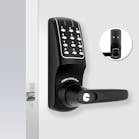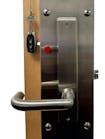What’s the most common lock in the world? Yes, the simple padlock. It has been used for several thousand years, dating back to the Roman Era. Like today, the “padlocks” of that time were used to defend against theft, unauthorized entrance, vandalism and sabotage. In China, the earliest use of padlocks was from the late Eastern Han Dynasty (25-220 AD) and in Europe, padlocks with spring tine mechanisms date back to 850 AD. It was during this time, between 850 AD – 1000 AD, when the “padlock” name was coined. The word was contrived from the lock’s application on livestock paddocks. The earliest padlocks were made from bronze; however brass, silver and other materials were also used.
Over time, the padlock’s usability changed significantly with innovations, particularly with the lock itself. There are two basic types of padlock locking mechanisms: integrated and modular. Integrated locking mechanisms directly engage the padlock's shackle with the tumblers. They do not allow disassembly of the padlock and often require the key to lock it. Modular locking mechanisms do not directly employ the tumblers to lock the shackle, so the key is not required to lock the padlock. Instead, these locks have a plug within the cylinder that, with the correct key, turns and allows a mechanism to retract from notches cut into the shackle. Padlocks with modular locking mechanisms are often taken apart by locksmiths so they can change the tumblers or service the lock. That work is still done today, although padlocks have become much more sophisticated.
It goes without saying that innovation and electronic technology have breathed new life into the “simple padlock” concept. In this article, we will explore higher security padlocks options, padlock applications, and how you, the security professional can go about increasing your padlocks sales.
Padlock Options
The wide spectrum of padlock options available today is indicative of the market’s demand for greater levels of physical security, as well as the need for access control and accountability in remote locations. Because of the wide variety of uses for padlocks, a locksmith/security professional should have a good knowledge of the padlocks available and the attributes that make them unique, and why they would be applicable to suit a customer’s need for a higher level of security and accountability.
High security mechanical padlocks have a boron alloy steel shackle that resists cutting, and the increased tensile strength helps resist pulling attacks. The boron alloy steel also ensures that the shackle has an exceptional degree of ductility and is not brittle. Top manufacturers also fortify their cylinders with hardened, stainless steel inserts to provide the ultimate defense against drilling, pulling and other forms of physical attack.
Mechanical padlocks can also offer patent protection, key control and physical security. A patented key control program will prevent the unauthorized duplication of keys and will help maintain the system’s integrity. Padlocks in these key control programs can be keyed alike, keyed differently, or master keyed with an existing door hardware system.
If greater security is needed, especially in a remote location, a padlock with a digital cylinder is an ideal solution if part of a comprehensive intelligent key system or electronic access control system. The Intelligent Key system will provide additional security elements including access control, scheduling and accountability. These sophisticated electronic padlocks will require an electronic key, fingerprint, eye scan, key card, code or other credential to open the lock.
There are also weather-resistant padlocks in either mechanical or electronic platforms. Usually made of durable, industrial grade stainless steel, they offer excellent resistance to harsh weather conditions and extreme environments. Some manufacturers will shroud the shackle and protect the padlock body with a weather-resistant coating. These padlocks are built to withstand severe conditions that are common on the back of a freight truck, an airport perimeter fence, or a remote substation on the top of a mountain.
High-End Applications
Let’s look at a few applications where a high-end padlock can be a deal maker.
Small and Medium Size Business (SMB): The places where a high security padlock can be used in the small and medium sized business space is endless. Gates (storefront and industrial), cabinets, document storage and control, storage buildings, toolboxes and outdoor equipment, shut-off values and equipment lock-outs, cages, trailers, and delivery trucks are just a few areas where your customers may need the protection of a padlock. In these often unmanned and unmonitored areas, customers are looking for greater resistance against physical attacks, and prevention of unauthorized key duplication, for these non-traditional openings. These areas are often overlooked when it comes to security enhancements, and can create security gaps if not addresses. Many commercial customers also seek out padlocks that can be quickly and easily integrated with existing door hardware key systems, adding the benefit of one-key convenience.
Power Utilities: Public utilities are regulated by the federal government (Federal Energy Regulatory Commission or FERC). Already in play is a mandate will come into play that will require all public utilities to have a security program in place. In addition, every utility must provide physical security—as well as access control and accountability--on all openings, including remote locations. Compliance with FERC represents a huge opportunity for security professionals who can provide utilities with a solution for perimeter security, one of the critical infrastructure protection standards.
Transportation: In the U.S., cargo theft results in approximately $15 billion in losses annually, with the average value of the each theft being worth approximately $145,000. This includes theft of cargo from shipping, trucking, portable storage, and even the retail sector, and can include items such as vehicles, foods and beverages, electronics and computers, and even household items like appliances. Not only are these items at risk while in transit, these items are also vulnerable once they reach a destination where cargo is temporarily stored in warehouses before pick-up or further deployment. High security padlocks increase the physical protection of cargo and containers, and can prevent entry from a rouge or unauthorized key. When digital or intelligent padlocks and keys are used to protect cargo, a schedule can be set to where the key only work once the cargo has made its way to its final destination where only authorized individuals will have access. Digital padlocks and keys can also offer an audit trail that details when the padlock was opened, and by whom.
There are other opportunities for higher security padlocks in the transportation sector. These opportunities includes padlock applications for perimeter fencing or access points around airports, freight and passenger rail applications that include securing freight cars, switches, and signals, as well as highway and motor carrier applications that include protecting roadway structures, bridges, and tunnels.
Each of the above padlock applications has the potential to bring new sales—and new customers--into your security business. Remember, your distributor/wholesaler is there to help you. This relationship can help build your business. The distributor can assist you in many ways, including having a padlock inventory that is ready for delivery.
Padlocks As A Profit Center
Are padlocks a growing profit center in your operation? If not, you could be missing out on significant sales opportunities. Here are a few ideas to boost your padlock business:
- Consider e-commerce if you do not already have an online presence. Padlocks are a great solution that can be sold online easily.
- In the shop, be creative and use point-of-purchase displays on your counters. That way, your customers can feel the heft of a high-end padlock when compared to a box store padlock.
- Use padlocks in your shop and on your equipment, as customers like to see you use the products you promote.
- And finally, train your salespeople and technicians to ask questions and to look for those applications (non-traditional doors) that expose risk to your customer, but are often overlooked. For example, out of the approximately 100 customers you see each week, if 10% spend another $150 or more on a padlock, you could achieve an addition $78,000 or more in sales for the year.
You can also utilize Medeco’s padlock selector at www.medeco.com to find the right padlock for the right application. A link to the padlock selector is located at the bottom of every web page on Medeco’s website.
Remember the padlock when you present your customers with security solutions. Innovation in the high-security market has turned this once simple lock into a potential money-maker.
Dale L. Bowman, CML, CPP, PCI, PSP, and LEED BD+C is the Director of Customer Success for Medeco Security Locks, an ASSA ABLOY company. Medeco is the leader in high security, key control, and intelligent key system designs, and has been helping organizations with their key system challenges for over 50 years.
Dale L. Bowman
Dale L. Bowman, CML, CPP, PSP, PCI, LEED BD+C, is Medeco’s director of business development, OEM and international sales.






